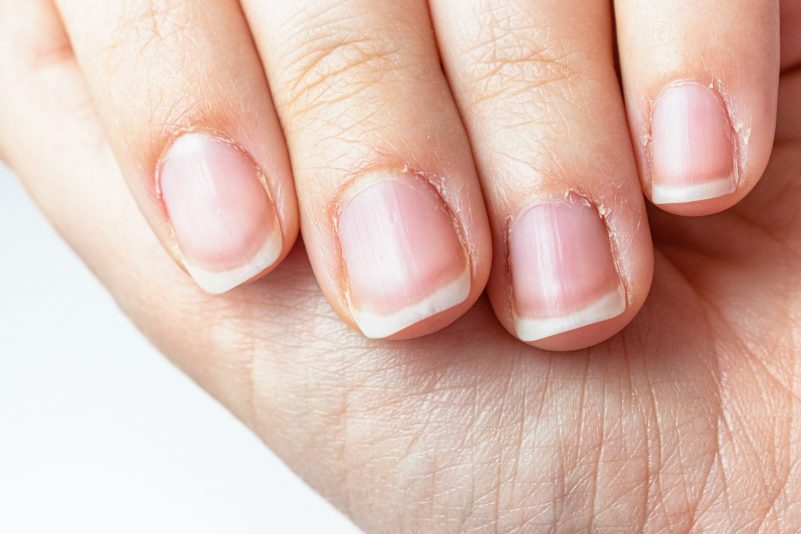Is it possible that your fingernails hold the secrets to your health? Can they show you nutrition deficiencies, underlying systemic issues, injuries, or toxic loads from medications? Amazingly, they hold clues into the mysteries that make up your overall health. While your fingernail health is not a stand-alone diagnostic tool, it can help you recognize potential issues that can be further investigated.
What do your nails say about your overall health? Find out today!
What Fingernail Health Says About Your Overall Health
1. Soft or Weak Nails
Soft or weak nails often bend before snapping. Like brittle nails, soft nails may be a fingernail health sign that points to overexposure to moisture or chemicals like detergent, cleaning fluids, nail treatments, and nail polish remover.
However, weak nail may also be associated with a deficiency in B vitamins, calcium, iron, or fatty acids. Other signs of vitamin B deficiency include pins and needles tingling in hands and/or feet, fatigue, pale skin, fast heart rate, mouth pain or swelling, red smooth tongue, and/or depressed moods or mental health changes (1, 2, 3).
How can you improve fingernail health when they are soft and weak? Reduce the amount of chemical exposure to your nails. Give your nails a break from polish and/or remover. If other sign point to vitamin and mineral deficiencies, try to increase your intake.
2. Pitted Nails
When you look at your nails, do you see evidence of pitting? Nail pits are small round depressions or notches appear in the nails. Nail pitting is common in those with skin conditions including psoriasis and eczema. It can coexist with psoriatic arthritis, or may be related to alopecia areata — an autoimmune disease that causes hair loss (4).
How can you improve fingernail health if you see nail pitting? If you see nail pitting, it’s worthwhile to talk to your medical provider. Often, this is associated with inflammation or disorders of other connective tissue including skin and joints. You may talk about ways to decrease overall inflammation while supporting connective tissue health.
3. Peeling Fingernails
Peeling fingernails can be tricky. It is often due to external trauma. However, it can also be caused by having a low iron status internally. So, which is it for you?
One way to figure it out is to look at your toenails. If they are peeling as well, it’s more likely to be an internal, possibly iron, issue.
Other iron deficiency symptoms include unexplained fatigue, dark undereye circles, spooned nails (see below), heavy, rather than springy, legs when you walk or run, or newly formed paleness. Iron-deficiency can be assessed and diagnosed with laboratory tests including serum ferritin (5).
How can you improve fingernail health when they are peeling? If caused by external trauma, refrain from using your fingernails as a tool, pressing into the nail too firmly, or using acrylic polish on nails. If caused by iron deficiency, talk to your medical provider about testing serum ferritin levels and/or adding iron-rich foods or supplements.
4. Brittle Nails
If your fingernails are rough or splitting, you may have what’s called onychoschizia. It’s actually quite common. Typically, it does NOT point to an internal health problem, but a drying out due to repeatedly wetting and drying your hands and nails, such as when washing hands, doing dishes, etc.
How can you improve fingernail health when they are brittle? Try using hydrating lotions on your hands and nails to protect them from wetting and drying. Consider wearing gloves while washing dishes or doing other water-heavy tasks.
5. Fingernail Ridges
Do you have thin vertical ridges that run from the tip of your fingernail down to your cuticle? If so, don’t fret, these are usually not a cause for concern or an indication of a health issue. If you have horizontal ridges, it may or may not be an indication of a health condition or a side-affect of treatment. For example, this horizontal grooves, call Beau’s lines, are often caused by chemotherapy and show up across all 20 nails in accordance delivery of the medication. In addition, Beau’s lines have been associated with systemic issues such as measles, mumps, malaria, typhoid fever, scarlet fever and hand-foot-mouth disease – in these cases people are typically diagnosed with the issue and then notice the ridges (6).
How can you improve fingernail health when you notice ridges? If you notice vertical ridges, you can ignore them or gently buff the surface of your nail with a fingernail buffer to smooth them. If you notice horizontal lines, you may attribute it to a known medication or medical issue, or you can see a healthcare professional to find the underlying cause.
6. Thick Yellow Nails
Yellow nails are actually relatively common. They can be caused by an infection or a reaction to a product, such as nail polish. Yellow, thick nails are a different issue. If you notice your fingernails or toe nail are thick, peeling, and discolored, it could be a nail fungal infection, known as Onychomycosis (7).
In rare cases, yellow nails can indicate a thyroid condition, skin conditions, or blood sugar abnormalities.
How can you improve fingernail health when they are yellowing and/or thick? Suspect a nail product as the culprit? Discontinue use and monitor changes. If not thickening, but also not due to a product, talk to your medical professional about potential causes. If your nails are thickening and yellowing, talk to your medical professional about possible fungal infection and treatment.
7. Black Lines on Nails
Black lines on nails are also called a splinter hemorrhage. These black lines, which can appear brown or dark red, may look like splinters, and there may be more than one. Typically, these black lines are caused by trauma to the nail. As the nail grows out, they should disappear if due to injury.
When they don’t and in rare cases, the lines could be a sign of an underlying issue, including skin, heart, or nail cell issues (8).
How can you improve fingernail health if you see black lines on them? If form trauma, give it time. The lines should disappear as your nail grows out. If there’s no change over a few weeks, talk to your healthcare professional and monitor any other symptoms, such as inflamed skin, night sweats, or bleeding in the nail.
8. Nails with White Spots
If you see scattered white spots on your nails, it can be a sign of zinc deficiency. It may also be an allergic reaction to a product, fungal infection (see thick yellow nails), or injury to the nail.
Other signs of zinc deficiency include unexplained weight loss, wounds that won’t heal, lack of alertness, decreased sense of smell and taste, diarrhea, loss of appetite, and/or open sores on the skin.
How can you improve fingernail health if you see white spots? First, give your nails a break from polish or other products and allow the nail to grow. If the spots remain or reappear, or you have other signs of low zinc status, talk your healthcare professional about possible zinc deficiency and supplementation.
9. Spooned Nails
Spoon nails are soft nails turned up around the edges, creating “spoons.” This condition also is called koilonychia and are often are a symptom of iron deficiency anemia. Iron deficiency anemia can be caused by inadequate iron intake or absorption, bleeding, gastrointestinal disorders, and more.
As mentioned above, other iron deficiency symptoms include unexplained fatigue, dark undereye circles, peeling nails (see above), heavy, rather than springy, legs when you walk or run, or newly formed paleness. Iron-deficiency can be assessed and diagnosed with laboratory tests including serum ferritin (9).
How can you improve spooned fingernail health? Since this is often caused by iron deficiency, talk to your medical provider about testing serum ferritin levels and/or adding iron-rich foods or supplements.
General Recommendations to Take Care of Fingernail Health
Fingernails are an epithelial skin appendage. They are made of a hardened nail plate surrounded by specialized epithelial surfaces. The nail plate (the portion of the nail you see on top) is formed of keratinised epithelial cells. Fingernails are incredibly dynamic and grows distally at a rate of over 3 millimeters per month!
As described above, fingernails can display signs of connective tissue health, nutrient deficiencies, and systemic issues. It stands to reason then, to support connective tissue health and adequate nutrient intake. From there, if your fingernails still show abnormalities, you may find evidence of other underlying or systemic conditions.
To take care of fingernail health in terms of connective tissue support, reduce inflammation, and adequate nutrient intake, consider adding:
- Collagen Powder (supports connective tissue)
- A Food-Based Multivitamin/Multimineral
- Anti-Inflammatory Foods and Supplements
- Strategies to Increase Needed Minerals and Glutathione
In addition, consider giving your nails regular breaks from harsh polishes, glues, and other chemical agents that may harm them.
Bottom Line
Your fingernail health may hold clues to your internal health. While they are not a stand-alone diagnostic tool, they can be the first indication of an issue. Take care of your fingernails and monitor any signs or symptoms of abnormalities. What are your fingernails telling you?


















